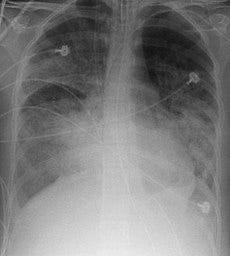In ARDS, substandard ventilator care is the norm, not the exception

In acute respiratory distress syndrome (ARDS), anyone with the keys to a ventilator knows low tidal volume ventilation (~6 mL/kg ideal body weight) is standard care. Low tidal volume ventilation can prevent or ameliorate ventilator-associated lung injury ; if early clinical trials represent current reality, one in 11 people with ARDS treated by low tidal volume ventilation could have their lives saved or extended while in the hospital.
As with any standard care implemented by human beings and our systems, low tidal volume ventilation as an ARDS treatment is not practiced perfectly. But surely top academic institutions come close ... right?
In one study, authors prospectively followed 485 patients with ARDS at Johns Hopkins and University of Maryland hospitals, obtaining their recorded ventilator settings twice daily (a total of 6,240 vent settings or 8 per patient). Investigators followed the patients for two years after diagnosis, comparing their survival according to how consistently they were treated with low tidal volume ventilation. They published their results in Open BMJ.
Only 41% of the observed ventilator settings were compliant with low tidal volume ventilation guidelines for ARDS. And 37% of patients were not treated with low tidal volume ventilation (according to the collected ventilator settings).
The degree to which a patient's physicians and care team adhered to low tidal volume ventilation practice directly correlated with that patient's chances for survival at two years. Each additional measured ventilator setting adherent with low tidal volume guidelines for ARDS reduced the risk of mortality at two years by a relative 3% (P=0.002).
In a follow-up study published in 2014, authors concluded that each 1 ml/kg IBW in excess tidal volume on initial ventilator settings resulted in a 23% relative increase in mortality; each subsequent increase of 1 ml/kg increased mortality by 15%.
How to Improve Ventilator Care for ARDS
The observed 40% adherence with low tidal volume ventilation for ARDS at a top U.S. academic medical center in 2012 is probably indicative of low adherence with LTVV throughout the developed world:
At another academic medical center publishing data in 2016, only 27% of patients with acute lung injury received tidal volumes of 6.5 ml/kg or lower.
At 26 pediatric ICUs also reporting in 2016, adherence with LTVV in children with ARDS was only 33%.
Why is this proven therapy not more consistently implemented? Previous work has shown knowledge deficits and culture barriers, prevalent erroneous physician beliefs about supposed contraindications or just failing to diagnose ARDS, and forgetting to do it because no ARDS protocol was in place. In fact, these adherence rates represent a significant improvement over the very low LTVV adherence observed after the 2000 ARDSNet trial.
Authors argued:
Rigorous knowledge translation research, aimed at improving the implementation of clinical research into practice, is needed to maximise the public’s return on investment from clinical and preclinical research that established the short term efficacy of lung protective ventilation.
Other authors have reported that ARDS protocols, education initiatives, and visual dashboards flashing red for patients with higher tidal volumes can improve adherence with low tidal volume ventilation.
In our “don't ask, don't look, don't tell” medical culture ever-fearful of lawsuits, bad press and the quality police, credit is due to centers with the confidence and courage to self-examine and report on their own practice and performance. Any areas for improvement found at leading academic centers are overwhelmingly likely to be present at most other community and academic medical centers. Before saying "We don't have that problem here," I'd ask: How would you know?
Read more:
Ward SL et al. Poor Adherence to Lung-Protective Mechanical Ventilation in Pediatric Acute Respiratory Distress Syndrome. Pediatr Crit Care Med. 2016 Oct;17(10):917-923.
Nota C et al. The impact of an education program and written guideline on adherence to low tidal volume ventilation. Crit Care Resusc. 2016 Sep;18(3):174-80.
Christopher P Bourdeaux et al. Increasing compliance with low tidal volume ventilation in the ICU with two nudge-based interventions: evaluation through intervention time-series analyses. BMJ Open 2015
Needham DM et al. Timing of Low Tidal Volume Ventilation and Intensive Care Unit Mortality in Acute Respiratory Distress Syndrome. A Prospective Cohort Study. AJRCCM 2014. https://doi.org/10.1164/rccm.201409-1598OC
Needham DM et al. Lung protective mechanical ventilation and two year survival in patients with acute lung injury: prospective cohort study. BMJ 2012;344:e2124.


